Lyotard: A short history of one of the most widely used pedals in cycling
Posted: Monday 21st September 2020
Given the long history of Lyotard (over 70 years) and their importance in the development of pedals it is surprising that virtually nothing has been written about them. The purpose of this article to right this and provide information on a company who produced a solid range used by many racers and tourists. They may not have been top of the range but they were extremely widely used.
Throughout much of the post-war period this French firm held a dominant position in the lightweight pedal market. Being fitted both as original equipment by most of the major British manufacturers and sold as accessories via the two major importers Ron Kitching and Holdsworthy.
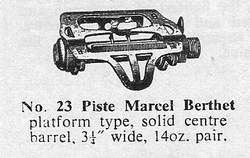
Pierre Lyotard founded the company in the early 1920’s. During that decade they produced the first versions of the pedal, which I would argue, was their most innovative contribution to cycle development, the “Marcel Berthet “ platform pedal (left). The foot rested on a wide platform, by its nature it was extremely comfortable especially for riders with broad feet. It needed to be used with toe clips as it was single sided.
It was named after Marcet Berthet a French racing cyclist who held the hour record three times twice in 1907 and once in 1913, he was the principal rival of Oscar Egg the Swiss rider who later invented the Osgear
The Marcel Berthet became known as the MB23 and remained in production until the mid 1980’s. Just before the war the shoe pickup plate ceased to be one piece (later examples are illustrated in both fig 2 and fig 3). The earliest reference I can find to this pedal in Britain is in an advert in the CTC Gazette in 1939 when it is referred to as the ‘ Continental’. For a component with such a long history there were remarkably few variants. However in common with other Lyotard pedals there were different thread lengths for steel or alloy cranks and the MB23 TF which had threaded holes for toe clips.
It was very popular with cycletourists due to the high degree of comfort. During the bike boom years of the 70’s Shimano, MKS and SR produced copies. One MKS copy, the 505, was counter weighed so the platform side always faced upwards-facing toe clip entry easy. Earlier in the 50’s Constrictor copied the design with their Asp model. A very high quality copy was produced by the British firm Barelli based near Cambridge in the late 70’s . This featured a range of detachable plates and is now extremely collectable.
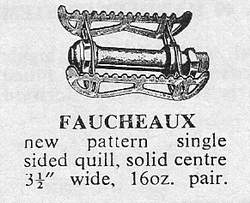
Another model with a very long history also named after a racing cyclist was the Faucheaux, which was, produced from the early 30’s for forty years. This was a single sided toothed model with the other side cut away . It was named after another French cyclist Lucian Faucheaux who had come second in the 1000 meters sprint at the world track championships in Paris in 1922.
A good example of Lyotard’s range can be seen (right) and it is instructive to note how little change there was to the basic range of models during 21 years.
Classification of the Lyotard Range:
1. Platform design; the MB 23 as discussed above
2. Double sided pedals
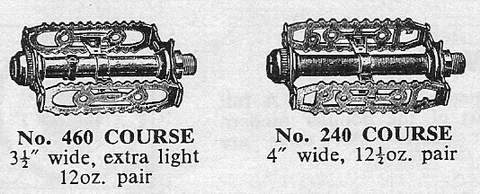
Of these the most widely found is the 460 there were a number of versions of this design: a chromed steel range, a duralumin model and a wider version the 240 (4” as opposed to 3 ½”). The 240 had P and L incorporated into the side plates, as was common practice with other pedal manufactures e.g. Chater Lea, BSA and Webb. In common with many other components the quality declined. The main complaint from users being that pedal frames creaked and needed to be removed from the crank and regular hammering. However, there was one exception the final 460 had reinforced axles at the crank end a response no doubt to complaints about breakages.
An interesting variant of the 460 was the 46, which featured flat side plates on one side and concave on the other. This it was claimed allowed relaxation of the foot
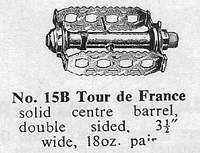
The Tour de France (no 15) which can be identified by having four cut outs in the side plates also had a very long history. This pedal was very similar to some Victorian and Edwardian designs a fact that did not escape Frank Whitt in his VCC publication “ The Restoration of Veteran Cycles” in which he recommends this model stripped of its chrome and nickelled as suitable for a much earlier machine.
One of the great advantages of the doubled sided design is that the rider has choice whether or not to use toe clips.
Lyotard also produced a white split rubber pedal (i.e. with four pieces of rubber), which was a common fitting on French women’s bikes of the post war period.
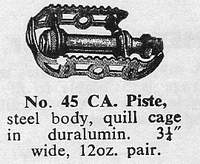
3. Quill Pedals
I do not agree with the statement in the 1960 Ron Kitching catalogue that Pierre Lyotard was the original designer of the quill pedal. I have seen turn of the century American Star pedals with this design. However he did develop the design and was the first to produce the modern quill pedal so widely copied in the 60’s and 70’s by virtually every pedal maker.
The most common quill design was the no. 45 (left), which again was a very widely copied design. Like many of their pedals Lyotard produced in a number of different versions, which varied in the use of alloy and or steel
On of their last pedals was of this design the Mod 82, which was a robust one-piece cast model with a black plastic dustcap.
4. Single sided no quill
The Faucheaux discussed above was an example of this type the earlier version had the side pages screwed on this ceased about 1955 with cheaper riveting being substituted. Also produced were the 462, which was a singled sided version of the 460. These pedals were slightly lighter than quill version but they did have the disadvantage of not having the protection of the quill for the pedal body.
Pricing and the later years
Lyotard were in terms of price near the bottom of the market. Looking at prices in 1962 they range from 9/- to 16/- the latter being the MB23. Only Phillips was cheaper and to put these prices into context Campagnolo pedals were 72/-.
Their decline and end of production in the late 1980’s was caused by three factors: the rise of the mountain bike, which used a wider squarer type pedal. Secondly the emergence of cheaper far Eastern manufacturers. Finally the move to clipless, which effectively ended the market in quality traditional pedals. Since the early 1990’s Campagnolo and Shimano have only produced clipless pedals. In common with many other French components manufacturers there was very little innovation. By 1980 their basic designs were at least 30 years old as a comparison of figs 2 and 3 shows.
Identification and Dating
Very few Lyotard pedals actually have the manufactures name on them the exceptions are the later Type 82, the MB23 (which is anyway a unique design). Often the easiest ways to determine if the pedal is Lyotard is by the dust cap. With the exception of a few later models this is a screw octagonal fitting with’ Lyotard Made in France ‘stamped on it. The later steel pedals e.g. the 36 had a press on dust cap, which presumably the accountants had worked out, saved a few cents. A very bad idea as they were often lost and various DIY tricks needed to be resorted to prevent this.
Pre 1960 versions of the Faucheaux and others including the 460 featured oilers in the barrel. Another way of dating earlier versions is that the side plates were screwed rather than riveted on. This later practice ceased around 1956.
Lyotard made pedals for Milremo, many of which are direct copies, especially of the 460D and type 36.
Lyotard pedals tend to be easily available at cycle jumbles. Never commanding high prices they remain probably the cheapest option for fitting period pedals to your restoration. For me the MB23 and the 460 remain some of the most comfortable pedals ever made they won’t cramp your feet or wear out cycling shoes. So the next time your return from a ride with aching feet you know which pedals to switch to.
References
Both Holdsworthy and Ron Kitching imported Lyotard and their Aids and Everything Cycling are a very useful source of information.
For 80’s models the Freewheel catalogues feature the final range
Adverts for Lyotard in the cycling press are extremely rare. (Lyotard do not seem to have been widely sold in Britain until the mid 1950’s)
F R Whitt The Restoration of Veteran-Cycles page 27 Pub. VCC
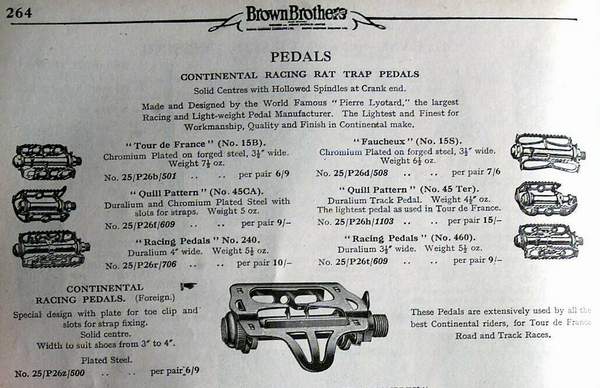
Pierre Lyotard pedals were very popular in the UK prior to the Second World War. They were marketed as Pierre Lyotard and Fonteyn’s in Percy Steet were one of the biggest British stockists pre-war. They sold 15b’s, 45CA’s, 45 Ter’s, 155’s, 460’s and 240’s no MB’s all through the 1930’s.
Brown Brothers also sold them during the same period calling them Continentals but used the same Lyotard
pattern numbers and mentioned Lyotard as the makers.
Harry Rensch used Fonteyns for the vast majority of his gen Continental kit. That’s why if you are lucky enough to find a 1935 onwards or pre-war Rensch with all its original fittings it will invariably have:
Simplex gears, Lyotard pedals, Simplex Ekla chainset, A.V.A Dura extension with Super Dura bends, Sportal
rims, Gloria brakes, Excelto hubs. He used mostly Wolber tubs and Jenatzy HP covers.
Posted: Monday 21st September 2020
This article appears in the following categories.
Upcoming Events
Whether you are looking for a gentle social meet up, or a 100-mile ride browse the community’s upcoming events and plan your next weekend outing.
